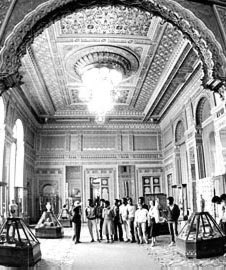|

Winter
1998 (6.4)
Architecture
of the Oil Baron Period
Taghiyev
Residence
Taghiyev
4
Interior
of Taghiyev's Residence which was converted into the History
Museum during the Soviet period. Below: The same room at the
turn of last century. Taghiyev (1823-1924) with his wife (Sona)
and three children (Leyla at piano, Mammad at violin and Ilyas
at cello).
The Taghiyev residence occupies
an entire city block and is located in a prime location close
to the sea. Oil Baron Taghiyev was in his 70s when he undertook
the project of building this opulent residence. He hired the
Polish architect Joseph Goslavski to design his home in the Italian
Renaissance style. Construction took place between 1895 and 1902.
The interior of this building is a must-see. It has an extraordinary
main gallery on the second floor with gilded arches and ceilings
and enormous plate glass windows. On occasion this hall is used
for State receptions.
As was true of all the wealthy Oil Barons, Taghiyev's property
was confiscated. One of his daughters, Leyla, escaped with her
three children to Persia even though he had forbidden her to
leave the country. Heartbroken from the news, he died two days
later on September 1, 1924. His residence was one of the few
that was not subdivided into numerous apartments. Instead, the
Soviets transformed it into the National History Museum, a function
that it still serves today.
Taghiyev's
monogram -
the single letter "T" carved in limestone-is barely
visible on the exterior of his palatial residence. It seems the
Soviets tried to chisel away at the letter, hoping to erase his
memory. Fortunately, they did such an unprofessional job of hacking
away at it, that its shape is still evident.
From Azerbaijan
International
(6.4) Winter 1998.
© Azerbaijan International 1998. All rights reserved.
Back to Index
AI 6.4 (Winter 1998)
AI Home
| Magazine
Choice | Topics
| Store
| Contact
us
|


